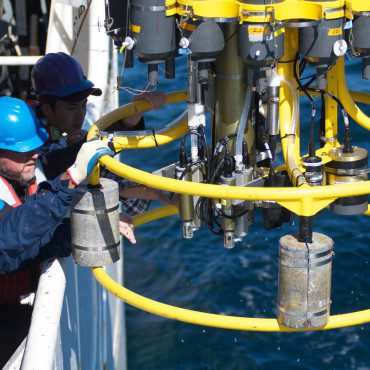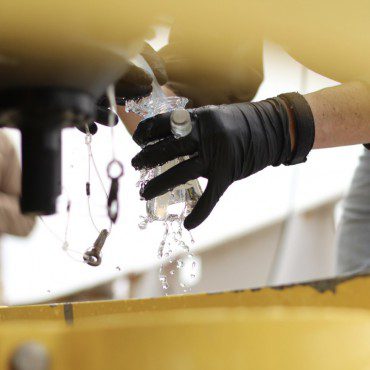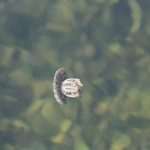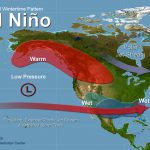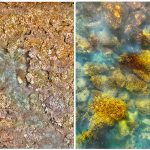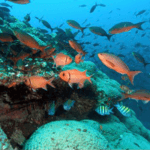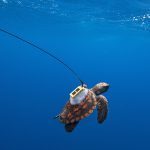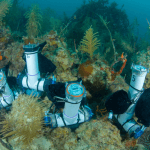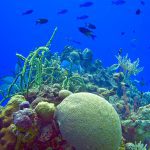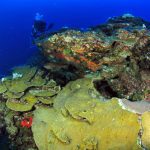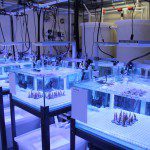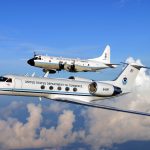View the cruise blog here: GOMECC-3 Blog
On July 18, NOAA AOML and partner scientists will depart on the Gulf of Mexico Ecosystems and Carbon Cycle (GOMECC-3) research cruise in support of NOAA’s Ocean Acidification Monitoring Program. This isn’t the first time researchers will head to sea in this region. Previous cruises have taken place along the east and Gulf of Mexico (GOM) coasts of the US in both 2007 and 2012. Together, these cruises provide coastal ocean measurements of unprecedented quality that are used both to improve our understanding of where ocean acidification (OA) is happening and how ocean chemistry patterns are changing over time. This will be the most comprehensive OA cruise to date in this region, set to include sampling in the international waters of Mexico for the first time. Ocean acidification is a global issue with global impacts, and international collaboration like this is vital to understanding and adapting to our changing oceans.

Left: 2007 cruise track departing from Texas in the GOM and arriving in Boston, MA.
Middle: 2012 cruise track starting in the GOM and moving along the Eastern coast of the US to Boston, MA.
Right: 2017 will be a more comprehensive sampling of the entire Gulf of Mexico (first NOAA sampling in Mexican waters), departing from Key West and arriving in Port Everglades, Florida.
Science at Sea:
This large-scale survey of OA trends and dynamics in the Gulf of Mexico will take place on board to NOAA ship Ronald H. Brown. The cruise track is designed to obtain a snapshot of key parameters as they relate to ocean acidification in the coastal realm, where marine life and those that depend on it thrive. During this cruise, scientists will assess environmental conditions, as well as the abundance, diversity, and health of marine organisms along the Gulf coast.
The carbon dioxide (CO2) content of the ocean closely mirrors the ever-increasing atmospheric concentration of CO2. Although carbon sequestration by ocean surface waters helps to regulate atmospheric levels of CO2, it comes at a cost to oceans and the life within. Ocean chemistry is changing in response to increased inputs of CO2, becoming more acidic from pole to pole.
Coastal waters are particularly vulnerable, as they experience a varying level of acidification due to both atmospheric inputs of carbon dioxide and anthropogenic influences, in addition to freshwater inputs from rain and influential rivers in the area. Coastal ecosystems are of great socioeconomic value, and changing ocean chemistry will have an impact on the ecosystems that support tourism and fishing industries throughout the Gulf. Consistent monitoring is necessary to equip NOAA with the tools to better prepare society to respond to changing ocean conditions and resources.
Scientists retrieving the CTD from the water on the 2015 East Coast OA cruise and taking a water sample from the CTD to measure oxygen concentration during the 2016 West Coast OA cruise. Image credit: NOAA.
The Cruise Track:
The GOMECC-3 cruise track will begin in Key West, Florida, and consists of 11 transects with a total of 107 sampling stations. Four of these stations will be sampled in collaboration with the National Park Service. Additionally, samples will be collected at two National Marine Sanctuaries. A rosette equipped with twenty-four bottles will be deployed to collect water samples at each station, which will be analyzed for salinity, oxygen, nutrients, dissolved organic carbon, total alkalinity, pH, partial pressure of CO2, dissolved organic matter, ocean color to verify satellite imaging and microplankton community distributions. Net tows will be conducted at select stations to collect samples of icthyoplankton (fish eggs and larvae) and pteropods, to characterize their distribution in the GOM.
A Team Effort:
The GOMECC-3 2017 cruise is truly a group effort. In all, 24 scientists and students from nine institutions representing three countries will sail with us. Shore-based collaborators and several science outreach and education organizations are partnering with us along the way to help share what’s being learned about ocean acidification in these waters.
To follow our progress throughout our mission, to learn more about the observations we are making, and to meet the scientists making these exciting observations, please visit our blog regularly. You may also find unofficial updates on twitter or Instagram using the hashtags #GOMECC3 or #GulfOA.
Originally Published July 2017 by Sierra Sarkis
